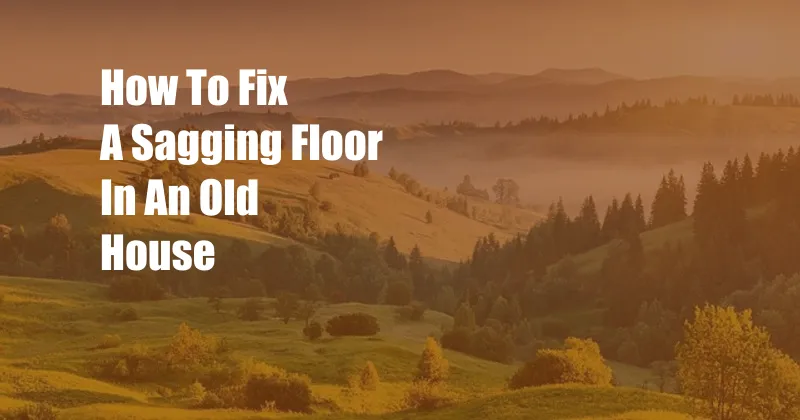
How to Fix a Sagging Floor in an Old House: A Comprehensive Guide
As an old house owner myself, I’ve experienced firsthand the unsettling feeling of a sagging floor. The creaks and groans with every step can be both alarming and frustrating. If you’re facing a similar issue, don’t despair. With the right knowledge and techniques, you can restore your flooring to its former glory. In this comprehensive guide, we’ll delve into the causes of sagging floors, explore various repair methods, and provide expert tips to help you tackle this challenge effectively.
Understanding Sagging Floors
Sagging floors occur when the floor joists, which are the horizontal beams that support the flooring, become weakened or damaged. This can be caused by various factors, including excessive weight, moisture damage, improper installation, or structural issues. Recognizing the underlying cause is crucial for choosing the appropriate repair strategy.
Common Causes of Sagging Floors
Understanding the potential causes of sagging floors is key to addressing the issue effectively. Some common contributing factors include:
- Overloading: Excessive weight on the floor, such as heavy furniture or prolonged storage, can put undue stress on the joists.
- Moisture damage: Water intrusion from leaks or spills can weaken the joists, causing them to rot or warp.
- Improper installation: Incorrect spacing or sizing of joists, inadequate support, or improper fastening can compromise the floor’s structural integrity.
- Structural issues: Foundation problems, such as settling or shifting, can put stress on the floor framing, leading to sagging.
Fixing a Sagging Floor: A Step-by-Step Guide
Repairing a sagging floor requires a systematic approach. Here’s a detailed guide to help you navigate the process:
- Identify the cause: Determine the underlying cause of the sagging to choose the appropriate repair method.
- Support the sagging area: Temporarily support the sagging area using jacks or props to prevent further damage.
- Replace damaged joists: If joists are severely damaged, they must be replaced. Install new joists of the same size and species as the existing ones.
- Sister joists: For less severe damage, sister joists can be added alongside the sagging ones. Sister joists are parallel beams that are attached to the existing joists to reinforce them.
- Install additional supports: In some cases, additional support may be needed, such as jack posts or cross-bracing, to strengthen the floor framing.
- Level the floor: Once the repairs are made, level the floor using shims or a leveling compound.
Expert Tips for Floor Repair
In addition to the step-by-step guide, consider these expert tips for successful floor repair:
- Consult a professional: For complex repairs or structural issues, it’s advisable to consult a qualified contractor or structural engineer.
- Use quality materials: Choose high-quality joists, fasteners, and leveling compounds for durable repairs.
- Allow for curing time: Follow the manufacturer’s instructions and allow sufficient time for adhesives and leveling compounds to cure properly.
- Prevent overloading: Distribute weight evenly across the floor and avoid overloading specific areas.
- Monitor and maintain: Regularly inspect your floors for any signs of sagging or damage and address issues promptly.
FAQ on Sagging Floors
For further clarification, here’s a comprehensive FAQ on sagging floors:
- Q: What are the warning signs of a sagging floor?
A: Creaking, sloping, or uneven floors, visible gaps between the floor and walls, and springy or bouncy floors.
- Q: Can sagging floors be prevented?
A: Yes, by avoiding overloading, preventing moisture damage, following proper installation techniques, and addressing any structural issues promptly.
- Q: What tools are needed to fix a sagging floor?
A: Jacks, props, shims, a level, a circular saw, a drill, and appropriate fasteners.
- Q: How long does it take to fix a sagging floor?
A: The repair time depends on the severity of the damage and the chosen repair method; it can range from a few hours to several days.
Conclusion
Fixing a sagging floor in an old house requires a combination of knowledge, skill, and the right materials. By following the comprehensive guide and expert tips outlined in this article, you can restore your flooring to its original condition and ensure a safe and comfortable living space. Remember, if you encounter complex repairs or structural issues, don’t hesitate to seek professional assistance.
Are you interested in learning more about home repairs and maintenance? Stay tuned for future articles covering various aspects of homeownership and improvement. Your feedback and questions are always welcome; feel free to leave a comment below.